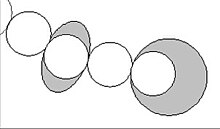Flory-Fox equation
The Flory-Fox equation (synonymous Fox-Flory equation ) is an equation for describing the viscosity of polymers as a function of the respective molar mass . She corrected the previously held assumption that the glass transition temperature of a linear polymer was the temperature with the highest viscosity, in that the glass transition temperature is the temperature at which the available space for molecular movement of a polymer becomes a given value.
properties
The Flory-Fox equation is:
with as viscosity number (in dl / g), as physical constant , as undisturbed mean length of a polymer (in cm), as molar mass (in g / mol), as a universal constant called intrinsic viscosity parameter and with as expansion factor . In a - solvent with takes the value 1, and the Flory-Fox equation turns into:
Another relationship was published by Flory and Fox:
with T g, ∞ as the maximum glass transition temperature that can be reached with a theoretically infinite molar mass, and K as the empirical constant that relates to the free volume. It is only suitable for large values of M.
A modified version of this relationship was published by Toshio Ogawa:
in which the inverse dependency of M is replaced by one of the square root of the product of the number average molecular weight M n and the weight average molecular weight M w .
Another modification was published by Thomas G. Fox and S. Loshaek:
However, the molecular weight is not necessarily a practical parameter for influencing the glass transition temperature, since the changeable range without changing the physical properties is small.
history
The Flory-Fox equation was published in 1950 by Thomas G. Fox and Paul J. Flory. In 1956, Thomas G. Fox also established the Fox equation .
literature
- A. Lederer, W. Burchard, A. Khalyavina, P. Lindner, R. Schweins: Is the universal law valid for branched polymers? In: Angewandte Chemie. Volume 52, number 17, April 2013, pp. 4659-4663, doi : 10.1002 / anie.201209228 , PMID 23512582 .
Individual evidence
- ^ Hershel Markovitz: Thomas G. Fox 1921-1977. In: Rheologica Acta. 17, 1978, p. 207, doi : 10.1007 / BF01535056 .
- ^ A b M. Alger: Polymer Science Dictionary. Springer Science & Business Media, 1996, ISBN 978-0-412-60870-4 , p. 201.
- ^ A b Thomas G. Fox, Paul J. Flory: Second-Order Transition Temperatures and Related Properties of Polystyrene. I. Influence of Molecular Weight. In: Journal of Applied Physics. 21, 1950, p. 581, doi : 10.1063 / 1.1699711 .
- ^ FR Schwarzl: Polymer Mechanics. Structure and mechanical behavior of polymers. Springer, Berlin / Heidelberg 1990, ISBN 978-3-642-61506-1 , p. 72. doi : 10.1007 / 978-3-642-61506-1 .
- ^ Thomas G Fox, Paul J. Flory: The glass temperature and related properties of polystyrene. Influence of molecular weight. In: Journal of Polymer Science. 14, p. 315, doi : 10.1002 / pol.1954.120147514 . ( PDF ).
- ↑ a b Paul Hiemenz, Timothy Lodge: Polymer Chemistry. 2007, CRC Press. ISBN 1-57444-779-3 .
- ^ Toshio Ogawa: Effects of molecular weight on mechanical properties of polypropylene. In: Journal of Applied Polymer Science (1992), Volume 44, p. 1869, doi : 10.1002 / app.1992.070441022 .
- ↑ TG Fox, S. Loshaek: Influence of molecular weight and degree of crosslinking on the specific volume and glass temperature of polymer. In: Journal of Polymer Science (1955), Volume 15, p. 371, doi : 10.1002 / pol . 1955.120158006 .
- ^ Thomas G. Fox, Influence of Diluent and of Copolymer Composition on the Glass Temperature of a Polymer System. In: Bull. Am. Phys. Soc. (1956), Volume 1, p. 123.

![{\ displaystyle [\ eta] = kM ^ {1/2} \ alpha ^ {3}}](https://wikimedia.org/api/rest_v1/media/math/render/svg/b459e039e394784ae66c8bb23a34fab7da2528a2)
![{\ displaystyle [\ eta]}](https://wikimedia.org/api/rest_v1/media/math/render/svg/e26da0088364c1b3d453c32ca10d160b58fe7f3c)








![{\ displaystyle [\ eta] = \ Phi {\ frac {r_ {0} ^ {3}} {M}}}](https://wikimedia.org/api/rest_v1/media/math/render/svg/fde555dbabdf850cc1b5b72bc17fcc31baef283b)



